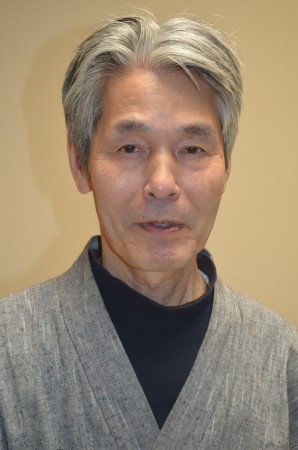Surrounded by forest, the house shows little more than a driveway to the cars rolling past on Spalding Drive.
But inside, this house feels different from the suburban homes around it. This Sandy Springs home offers a little piece of Japan. Since 1989, it has housed the Japanese Embroidery Center, a non-profit that preserves and teaches Japanese embroidery.
“We have about three acres of land,” said Kazumi Fujisawa, educational director of the Japanese Embroidery Center, a school housed in the home at 2727 Spalding Drive, and daughter of the center’s founder and master, Shuji Tamura, who lives at the house.
“You can see the seasons change from the classroom. When spring comes, you can see all the dogwoods bloom. It’s like snow. We call it ‘spring snow.’”
Visitors to the center remove their shoes in the entryway before entering the living area, just as they would at a home in Japan. The first room visitors enter is a sparely decorated space serving as a sort of gallery and meditation area.
“You step into their house, which is also their workshop, and it’s a completely Japanese world,” said Elizabeth Peterson, director of the Oglethorpe University Museum of Art, which mounted an exhibition of works from the center in February.
The exhibit, which lasts through March 6, features pieces covered with small stitches made with silk thread that create brightly colored images of plants, abstract designs and scenes. The show ties into an exhibit the center mounted at the Oglethorpe gallery in 1990, shortly after the center opened. “There’s a long-standing relationship and they’re our neighbors,” Peterson said.
Tamura established the U.S. center more than center a quarter century ago. The Japanese-style house is part of what attracted him to metro Atlanta after he decided to move to the U.S. to open a branch of the Japanese center where he took up the craft of embroidery, Fujisawa said. Fujisawa said the center now has about 500 members.
Tamura said he looked at locations in New York and California, but didn’t feel at home there. “In the beginning, the choice was New York or San Francisco,” Tamura said. “I knew it was not my place. When I got off the airport in New York, I felt [it was] dangerous. In L.A., I felt no nature. In San Francisco, I felt it was more a sightseeing city.”
A student from Atlanta had sent him a videotape showing the Spalding Drive house, which was for sale, Fujisawa said. “This house was already Japanese style,” she said. But it wasn’t really Japanese enough. They felt the house mixed in other Asian styles. “We had to remodel a lot,” she said.
They added a classroom on the rear of the house, where students come to learn embroidery skills. One of the first modifications to the house, Tamura said, was to build a new entrance. He had seen that Americans who came to his classes, which he then offered in hotels, wouldn’t stop talking. Even once class started, they would keep talking. That, he said, would never happen in Japan. “I was asking, ‘How can we make them quiet?’”
So he built a Japanese-style entryway and required students and visitors to remove their shoes. It was a way to calm them. “The entrance was very important,” he said. “To take shoes off is very common in Japan. I have to ask them to take shoes off. The first step was to build a typical Japanese entrance.”
Tamura, who’s now 75, said he took up embroidery when he was about 30. He grew up in Tokyo and had trained to work in the computer industry, he said, but didn’t like his job. He visited the embroidery center, located in the nearby town of Chiba, and “immediately, I realized this is my life’s work.”
He was drawn to the craft’s history, which stretches back more than a millennium. And he found the craft satisfying spiritually, he said. “It was a different world,” he said.

Fujisawa, who said she coordinates about 100 embroidery teachers scattered around the world, said the work is technically difficult and requires patience. Learning the craft has taught her about herself.
“For me, growing up, I was not the type of person who would do embroidery,” she said. “I would rather go outside and climb a tree. I was a tomboy. The state of your mind shows in embroidery. … I learned how to calm myself. It shows in your embroidery.
“I had to grow myself to be a good stitcher. That’s what amazed me. Embroidery is not the ultimate goal, but how much you grow inside, how much you change inside. A person becomes a more patient person. That’s the reason I’m doing Japanese embroidery – all this inner improvement.”
Nuido, The Way of Embroidery
Through March 6
Oglethorpe University Museum of Art, 4484 Peachtree Road, Brookhaven. The museum is located on the third floor of Lowry Hall on the Oglethorpe campus.
Hours: Tuesday-Saturday, noon-5 p.m.
Cost: $5, children younger than 12 admitted free



